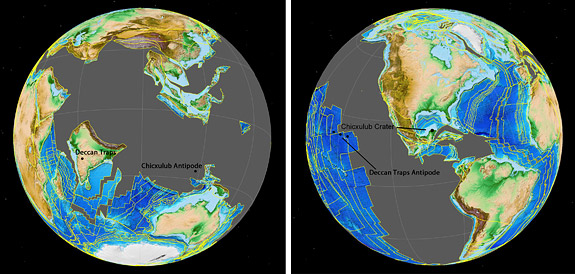The currently accepted theory for P-T mass extinction is environmental change triggered by the Siberian Traps volcanic activity.
A paper(1) suggests that the Siberian Traps were caused by a hotspot created after an impact event on what was back then the antipode of Siberia: the Wilkes Land crater.
Thus, the impact may have triggered the “Great Dying” at the end of the Permian and contributed to the development of the hot spot that produced the Siberian Traps and now may underlie Iceland.
However, another more recent review paper(2) mostly discredits this theory:
Finally the recent report of a 500-km-diameter impact structure of possible Permian–Triassic age in the Antarctic(1), is based entirely on satellite gravity measurements, provides no geological context, and completely ignores the absence of any predictable regional and global geological effects from such a large impact event, e.g., the absence of any thick ejecta layer at nearby Antarctic Permian–Triassic boundary sections.
Leaving aside the discussion of whether such a thing caused the formation of the Siberian Traps and thus the P-T mass extinction, in theory, can an impact on one side of the Earth cause volcanism on its antipode?
Also very important, why would this happen? What's the supposed mechanism that converts short term seismic activity to volcanic activity derived from long term hot spots?
Note that I'm not asking about in situ volcanic activity (such as the case of Sudbury). The impact also has to be reasonable in magnitude: I don't consider the moon-forming event that destroyed the young Earth as a reasonable impact in magnitude.
(1) von Frese, R. R. B., L. V. Potts, S. B. Wells, T. E. Leftwich, H. R. Kim, J. W. Kim, A. V. Golynsky, O. Hernandez, and L. R. Gaya-Piqué (2009), GRACE gravity evidence for an impact basin in Wilkes Land, Antarctica, Geochem. Geophys. Geosyst., 10, Q02014, doi:10.1029/2008GC002149.
(2) Bevan M. French, Christian Koeberl (2010), The convincing identification of terrestrial meteorite impact structures: What works, what doesn't, and why, Earth-Science Reviews, 98, Issues 1–2, Pages 123-170, doi:10.1016/j.earscirev.2009.10.009.
edit 18/10/2015
There was a paper published recently in Science that suggests that this is exactly what happened in the K-Pg extinction event. The Chicxulub increased the intensity of the Deccan volcanism, on the other side of the planet. Here are some links:
Volcano-asteroid combo may have done in the dinosaurs
Could dino-killing asteroid have pumped up giant volcanoes?
edit 31/12/2016
Not everyone agrees! For example:
Triggering of the largest Deccan eruptions by the Chicxulub impact: Comment
